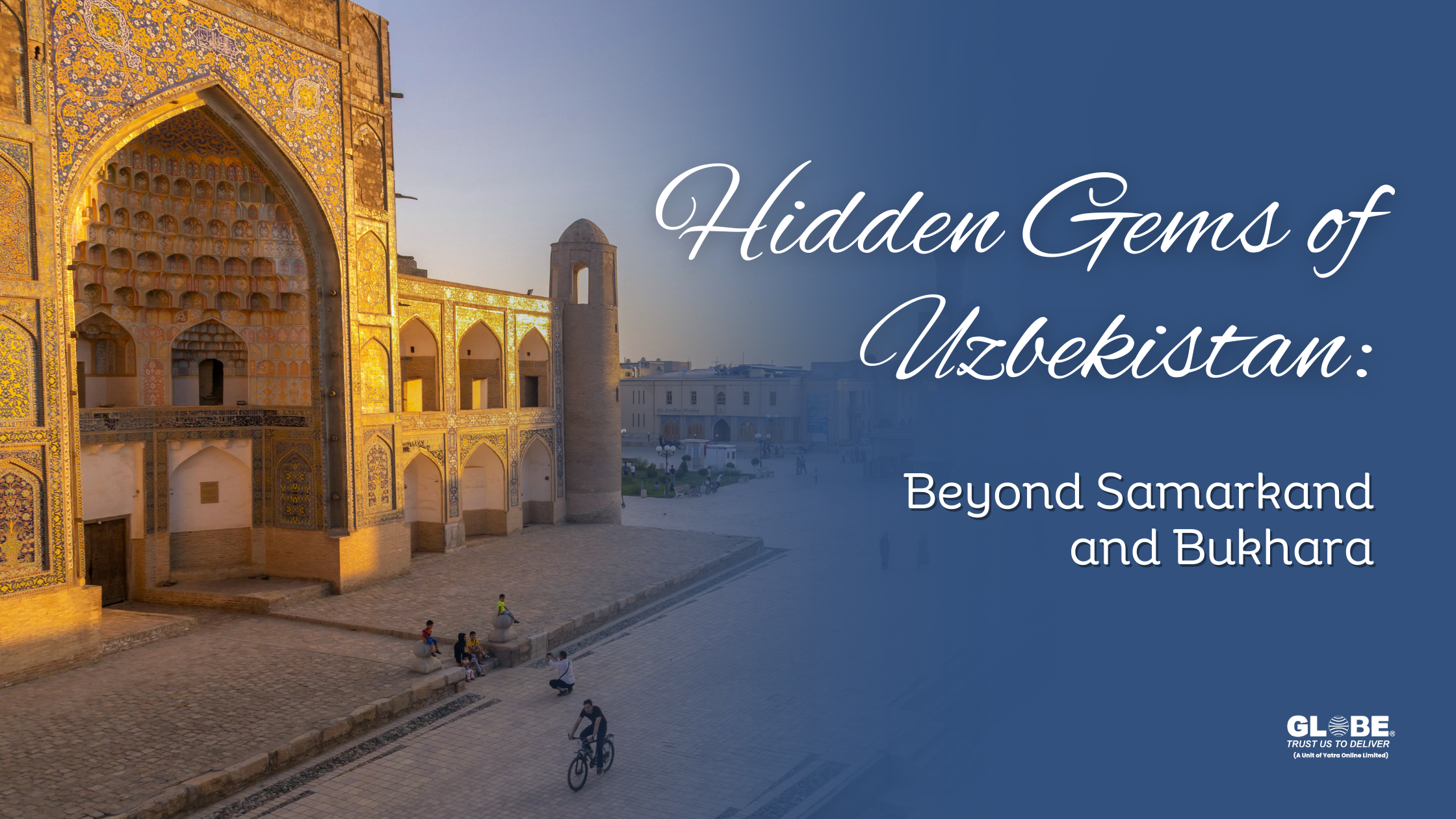Introduction
When travelers think of Uzbekistan, two cities instantly come to mind: Samarkand and Bukhara, the jewels of the Silk Road. Their dazzling mosques, caravanserais, and bazaars rightly earn global admiration. But Uzbekistan is far more than its two most famous cities.
Beyond these icons lies a country filled with mountain escapes, desert fortresses, rural traditions, and ecological wonders. Whether you’re an adventure seeker, culture lover, or history buff, Uzbekistan’s lesser-known treasures promise a deeper and more authentic travel experience.
In this guide, we’ll journey beyond the classics to uncover Uzbekistan’s hidden gems the places where the Silk Road’s spirit still whispers, untouched by mass tourism.
Khiva and the Desert Fortresses of Khorezm
a) The Timeless City of Khiva
- Unlike the grand scale of Samarkand, Khiva is intimate and atmospheric.
- The walled Ichan Kala (Inner City) is a UNESCO World Heritage Site filled with turquoise-tiled minarets and narrow lanes.
- Highlights include Kalta Minor Minaret, the Kunya Ark Citadel, and traditional craft workshops.
- Khiva feels like stepping back into a living Silk Road museum.
b) The Desert Fortresses of Ancient Khorezm
- Scattered across the Karakalpakstan desert are mysterious fortresses dating back 2,000 years.
- Known as the Elliq Qala (Fifty Fortresses), they were once thriving desert outposts.
Notable ones:
- Toprak Qala: An ancient palace-fort with preserved walls.
- Ayaz Qala: Located in the desert sands, offering spectacular sunsets.
Few tourists venture here, making it a true hidden gem of Uzbekistan.
Nukus and the Savitsky Museum
a) Nukus: The Forgotten City
- Remote and quiet, Nukus is the capital of Karakalpakstan.
- It’s often skipped by tourists, but it hides one of Uzbekistan’s greatest surprises.
b) The Savitsky Museum: The “Louvre of the Steppe”
- Home to 90,000 pieces of art, including avant-garde Soviet works banned in Moscow.
- Features ethnographic treasures of Karakalpak culture.
- Nicknamed the Louvre of the Steppe, it’s a must for art lovers.
- In the most unlikely of places, Nukus preserves an entire cultural heritage.
The Vanishing Aral Sea
a) A Tragic Wonder
- Once one of the largest lakes in the world, the Aral Sea has shrunk dramatically.
- Visiting the region is both haunting and educational.
b) Moynaq: The Ship Graveyard
- The town of Moynaq once thrived as a fishing hub.
- Today, rusting ships lie stranded in the desert where water used to be.
- A moving reminder of human impact on nature.
c) Aral Sea Eco-Tourism
- Adventure travelers can join jeep tours to the desolate seabed.
- Locals are working on eco-projects to preserve the fragile environment.
- The Aral Sea is a hidden gem for responsible travelers seeking meaning in their journeys.
Fergana Valley: Heart of Craftsmanship
a) A Cultural Crossroads
- The Fergana Valley is a fertile region where Uzbek, Kyrgyz, and Tajik cultures intersect.
- Known as the country’s craft capital.
b) Rishtan Ceramics
- Famous for blue-glazed pottery, crafted with techniques passed down for centuries.
- Visitors can meet artisans in their workshops.
c) Margilan Silk
- The Yodgorlik Silk Factory in Margilan still uses traditional ikat weaving methods.
- Perfect for travelers interested in the Silk Road’s textile legacy.
- The Fergana Valley is where Uzbekistan’s living traditions thrive.
Nuratau Mountains and Homestays
a) A Step into Rural Life
- Far from the bustling cities, the Nuratau Mountains offer community-based tourism.
- Homestays allow travelers to live with Uzbek families, sharing meals and stories.
b) Eco-Tourism Adventures
- Hiking trails reveal wild landscapes and ancient petroglyphs.
- Villages like Hayat and Sentob are pioneers in eco-tourism.
- This is a rare chance to experience the hospitality of rural Uzbekistan.
Chimgan Mountains and Lake Charvak
a) The “Uzbek Switzerland”
- Just a short drive from Tashkent, the Chimgan Mountains are a beloved weekend escape.
- Popular for skiing in winter and hiking in summer.
b) Lake Charvak
- A turquoise reservoir surrounded by mountains.
- Perfect for swimming, paragliding, or simply relaxing.
- Chimgan shows that Uzbekistan offers natural beauty as well as history.
Shahrisabz: The Birthplace of Tamerlane
a) Historical Importance
- Shahrisabz is the birthplace of the legendary conqueror Amir Timur (Tamerlane).
- Less visited compared to Samarkand, but historically rich.
b) Key Landmarks
- Ak-Saray Palace: Remains of Timur’s grand project.
- Dorut Tilavat and Dorus Saodat: Complexes with mosques and mausoleums.
- Shahrisabz offers a quieter but equally awe-inspiring historical experience.
Termez: Gateway to Ancient Buddhism
a) A Borderland City
- Located near Afghanistan, Termez has unique cultural influences.
- It’s safe for travelers but sees few visitors.
b) Ancient Buddhist Heritage
Once a major Buddhist center on the Silk Road.
Highlights:
- Kampyr-Tepe: Ancient fortress city.
- Fayaz-Tepe: Buddhist monastery ruins.
Termez reveals a different side of Uzbekistan’s Silk Road history.
Offbeat Experiences in Uzbekistan
- Camel Trekking in the Kyzylkum Desert: Sleep in yurts under the stars.
- Uzbek Wine Tasting: Samarkand’s Khovrenko Winery offers surprising vintages.
- Local Bazaars: From Tashkent’s Chorsu Bazaar to small village markets, a riot of colors and flavors.
Beyond landmarks, these experiences offer the soul of Uzbekistan.
Why Explore Beyond Samarkand and Bukhara?
- To avoid crowds and enjoy authentic interactions.
- To support local communities through eco-tourism and crafts.
- To discover a more diverse picture of Uzbekistan: not just turquoise domes but also deserts, mountains, and living traditions.
Conclusion
Uzbekistan is a country layered with history, culture, and natural beauty. While Samarkand and Bukhara shine as Silk Road icons, the true magic often lies in its hidden corners: the desert fortresses of Khorezm, the haunting Aral Sea, the craft villages of Fergana, and the mountain homestays of Nuratau.
Travelers who step off the beaten path are rewarded with unforgettable encounters—whether it’s sharing tea in a mountain village, standing before rusting ships in a desert, or watching the sunset over a 2,000-year-old fortress.
So, when you plan your journey to Uzbekistan, go beyond the classics. Because sometimes, the best treasures are the hidden ones.





